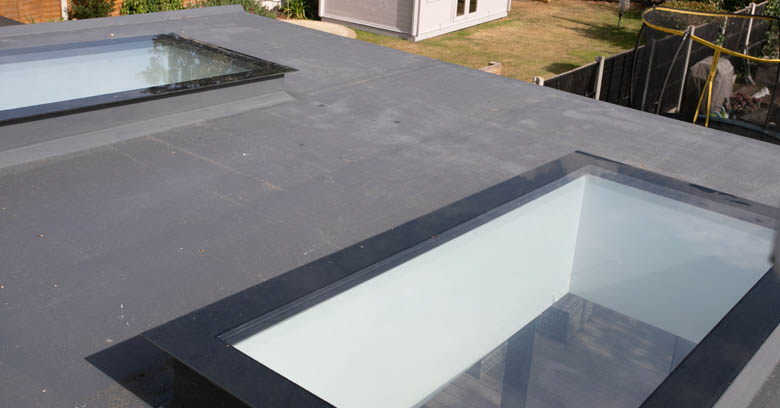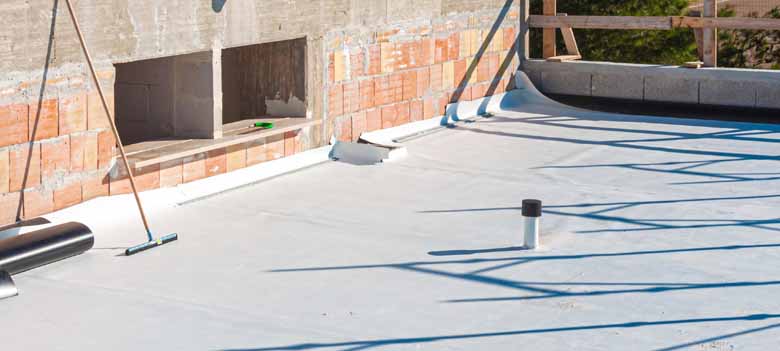When you’re planning a flat roof replacement or repair, one of the most important decisions you’ll make is the type of material to use.
The material you choose will decide the aesthetics of your home, the lifespan of the roof, how resistant your roof is to water leakage and even affect the value of your home.
Each flat roofing material has advantages and disadvantages to consider before installing your new flat roof.
Below we outline the top five flat roof materials available in the UK, considering cost, durability, longevity and flexibility.
1) EPDM rubber
EPDM rubber is fast becoming one of the most popular flat roofing materials in the UK.
It’s extremely budget-friendly, costing around £45m² on average. The only material that is more affordable than EPDM roofing is roofing felt.
One of the biggest advantages of EPDM rubber roofing is that it’s extremely easy to maintain due to its watertight seal. Simply sweeping across the surface or hosing it down will clear most items that end up on the roof, such as twigs and leaves.
EPDM rubber roofing is also an excellent choice for eco-conscious homeowners as it’s 100% recyclable and can be made from old car tyres among other things.
Overall, EPDM rubber roofing offers a perfect mix of affordability and durability, making it very hard to beat.
2) GRP fibreglass

Although GRP fibreglass is one of the most expensive roofing materials on the market, it also tops the charts for durability and longevity.
GRP fibreglass is the ideal choice if you’re a long-term homeowner who won’t be moving anytime soon. This is because GRP roofing normally lasts for at least 30 years, and in most cases even longer.
It’s also extremely durable and is unlikely to pick up any significant damage during that time, unless in exceptional circumstances. This makes GRP fibreglass roofing a great investment over a long period.
Like EPDM rubber roofing, GRP roofing is extremely easy to maintain.
One of the biggest advantages of fibreglass roofing is that it can be made seamless due to its flexibility. This means that flashings don’t need to be relied upon as much to protect the roof from water leakages and other issues.
3) Roofing felt
The most affordable roofing material on our list, roofing felt costs around £40m².
However, despite the low price, roofing felt still offers many of the same advantages as more expensive materials.
Firstly, roofing felt is extremely easy for roofers to repair due to the way that it’s added to the frame of the roof. A professional roofer simply needs to cut away the damaged area and repatch over it. This is especially handy for first time homeowners who might be operating on a budget.
Felt roofing is also extremely flexible making it suitable for most homes and structures, whether it be a garage or shed.
However, the biggest downside to roofing felt is that it can be easily damaged and because of this, felt roofs tend to have a smaller lifespan of between 10 to 20 years.
4) PVC

PVC roofing is extremely strong and long-lasting, with most PVC roofs having a lifespan of over 20 years.
The material has a water-resistant property, meaning that PVC roofing can withstand ponding, a common disadvantage of flat roofs.
PVC roofs are also extremely resistant to chemicals, fire, and wind, making it one of the safest roofing materials available in the UK.
A disadvantage of PVC roofing is that it has been known to shrink in cold weather conditions. If PVC or any other roofing material shrinks, it can leave holes and cracks which can result in water leakage. This can then potentially lead to the roof’s underlaying structure being damaged.
Also, if part of the roof is damaged and needs to be repaired, the whole roof must be replaced rather than just a specific area.
5) Green flat roofs
A recent eco-friendly alternative to other traditional flat roofing materials, a green flat roof is made up of a layer of turf or soil where various plant life can grow.
This has many advantages such as purifying the air and reducing the temperature while also absorbing rainwater that would normally lay on the surface of the roof.
However, despite the benefits, green roofs are more expensive to construct than traditional roofs. This is due to the underlying structure of the roof needing to be reinforced to support the extra weight and additional water ingress protection.
A green flat roof also prevents you from being able to use the surface of your roof for other things, such as a rooftop terrace or balcony.
If you’re still undecided about what type of roofing material is best for your home, why not head over to our roof replacement guide or roof repair guide to find out more.
Alternatively, visit our roofing page for the latest insights and advice, including cost guides and each type of roof.
To get quotes for flat roofing – post a job now.